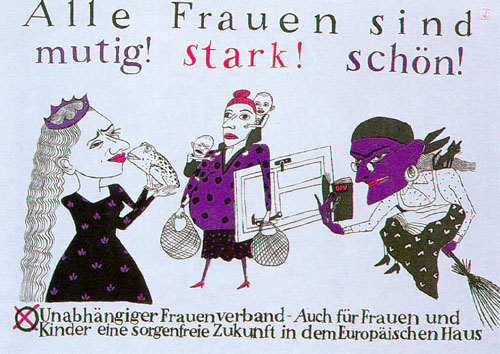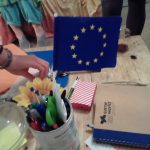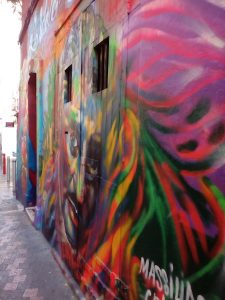Erasmus+ cooperation in area of adult education between
Finland, France,Germany, Poland and Spain
|
Connecting Memories: We focus on themes and taboos of debating history and methods of a democratic historical-political education. What do we know about the Franco dictatorship? What about the German unification process, what about the roots of right-wing extremism in Poland? Jump into the project’s idea. |
The project partners learn from each other by a) experiencing didactic approaches such as making documentaries, object games, community theatre or sociodrama and b) exchanging on history from different points of view. The cooperation results in teaching material on ‘memory education’ in a European horizon. |
We document our activities by photos and videos. Together we created audio postcards and street interviews. With pleasure we undertook small researches on how historical events are perceived by citizens in different countries. We have held local events to ‘anchor’ the project each organisation’s context. |
Connecting Memories’ latest news
The association Hors Pistes in Marseille hosted the first project’s Learning, Teaching and Training Activities in May 2018. Educational workers from a museum in Finland, a private university in Poland and NGOs in Spain, Germany and France learned from each other different methods of historical-political education.
The AHE university in Lódz hosted the second workshop in November 2018. Adult educators from each partner organisation shared creative methods to gain learner’s interest in history of the own and of other European societies. We got to know HERstory and learned about the multicultural past of Lódz. And we applied hand mapping, “thinking hats”, etc. Encouraging, inspiring, enriching…
Connecting the HERstory approach
During the project, we got inspired by our Polish partners who work with the HERstory approach. What does it mean? Inga and Edyta wrote an explanation including practical information on workshops following the HERstory method.

There is No Revolution to Make Without Women
HERstory and Dynamics of the Democratic Change of 1989 in the GDR
During our European cooperation, we have developed educational materials on women and the democratic upheavals of 1989. The women were often the ones who gave impulses, inspired and had the courage to start. In addition, there were associations such as the „Lila Offensive“ (Purpur Offensive) and the Independent Women’s Federation, which claimed for political feminist concerns. In Part I, the treatise on the topic, this is explained using examples. The appreciation of individual women and women’s groups is embedded in a presentation of the events that took place BEFORE the opening of the Wall on 9th November 1989. The description leads to a critique of current memory politics, in particular the narrative of a linear development of oppositional activities during the GDR, the „Aufbruch ’89“ (breakup ’89) and the German unification on 3rd October 1990. Instead, it pleads for the ideas of the citizens‘ movements – including those of women – from the period of the democratic upheaval for „peace, justice and the preservation of creation“ to be updated in view of current crises. Part II and Part III contain (suggestions to) exercises for educational work with adults on sensitive historical issues. They were commonly tested together during two 5-day workshops.

Ohne Frauen ist keine Revolution zu machen
HERstory und Dynamiken des demokratischen Umbruchs von 1989 in der DDR
Im Rahmen unseres Projektes wurden auch Bildungsmaterialien zu Frauen und den demokratischen Umbrüchen 1989 entwickelt. Oft waren sie es, die Impulse gaben, inspirierten und den Mut zum Anfang hatten. Daneben gab es Zusammenschlüsse wie die „Lila Offensive“ und den Unabhängigen Frauenverband, die politisch-feministische Anliegen vertraten. In Teil I, der Abhandlung zum Thema, wird dies an Beispielen ausgeführt. Die Würdigung einzelner Frauen sowie von Frauengruppen ist eingebettet in eine Darstellung der Ereignisse, die sich VOR der Öffnung der Mauer am 9. November 1989 zutrugen. Die Schilderung mündet in eine Kritik aktueller Erinnerungspolitik, insbesondere der Erzählung einer linearen Entwicklung von oppositionellen Aktivitäten während der DDR, dem „Aufbruch ’89“ und der Deutschen Vereinigung am 3. Oktober 1990. Stattdessen wird dafür plädiert, sich die Ideen der Bürgerbewegten – einschließlich der Frauen – aus der Zeit des demokratischen Umbruchs u.a. für „Frieden, Gerechtigkeit und Bewahrung der Schöpfung“ neu anzueignen und angesichts gegenwärtiger Krisen zu aktualisieren. Teil II und Teil III enthalten (Hinweise auf) Übungen für die Bildungsarbeit mit Erwachsenen zu sensiblen historischen Themen. Sie wurden während zwei 5-tägiger Workshops gemeinsam erprobt.




